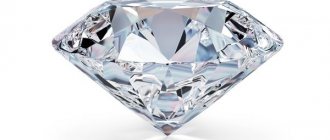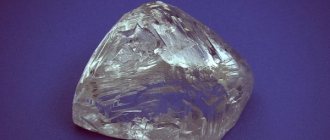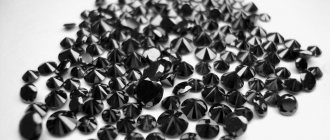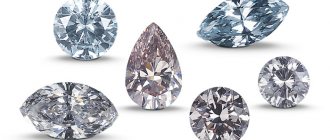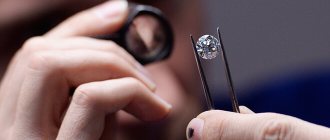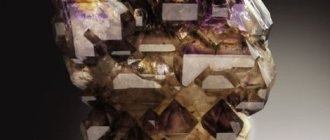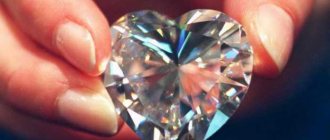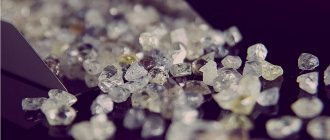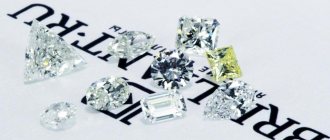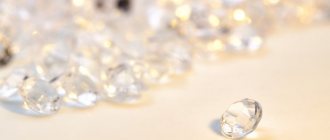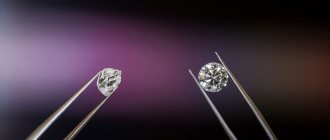A diamond is a diamond that has been processed by jewelers. The stone got its name from the French word “brilliant,” which means “brilliant, sparkling.” This is one of the most expensive gems in the world. Diamonds have become famous thanks to references in literature and art.
Story
Diamond is the true king of precious stones. But it received recognition only after they in the 15th century .
The mineral got its name from the Arabic word “almas,” which translates as “the hardest.” Each nation called this nugget differently, but all the names had similar meanings - “indestructible”, “solid”, “eternal”.
The Greeks called it "adamas", the Romans - "diamond", the British - "diamond". The designation for gem came into Russian from the Turkic “al mass”.
Like many gems, the diamond began its historical journey from the treasuries of Indian rulers. In India they mined this stone, but they did not know how to cut it due to the super-hardness of the nugget. Diamond became among the Hindus a symbol of firmness and inviolability of power.
When Alexander the Great brought a certain amount of these gems from his Indian campaign, Europe and the Middle East became acquainted with diamond nuggets.
A diamond gained its true brilliance and glory after being cut into a diamond. We learned how to cut super-hard stone in Flanders. There, after some time, they developed a cut with 57 facets, and the outfits of gentlemen and ladies of the Rococo era sparkled with diamonds. Since then, the diamond has become the most valuable gemstone available to few.
Color varieties
Hearing the name “diamond,” almost every person imagines a crystal-clear and dazzlingly brilliant colorless stone. But few people know that in nature there are several color varieties of the mineral. The main evaluation parameters are its own color and the presence of luminescence.
Incredibly, scientists still have not found an exact explanation for the appearance of color in diamonds. There are no impurities in them, like other gems. The most common version says that red, purple, blue, green, yellow and other specimens appear due to the exposure of stones to varying degrees of natural radiation.
Colorless (white) diamond
The classic white gem is a standard in the world of precious stones. But such stones (without defects and discoloration) are quite rare in nature. Most often, specimens have a yellowish tint and blue luminescence, which is why they appear colorless to the human eye. High-quality diamonds used in jewelry are considered to be samples without a tint or with a slight brownish tint, which necessarily fluoresce blue. All other stones are used in industry.
Colorless rough diamond
Black Diamond
The black variety of diamond has become popular relatively recently; previously, such a mineral was considered a waste product accompanying white standard crystals. Today, its value, thanks to demand, has increased greatly.
Black Diamond
Red diamond
One of the rarest types of gems, mined by the largest developers in single copies. Red diamonds are incredibly expensive. They decorate the windows of museums and private collections.
Red diamond
Purple Diamond
The rarest species, the cost of which can reach from several hundred thousand to millions of dollars. Such stones are considered the property of the country that discovered them.
Purple Diamond
Fantasy Diamonds
Other fancy diamonds include blue, green, pink, yellow, orange, and bright blue stones. All of them are quite rare in nature and are very highly valued. Their prices vary from several hundred, thousands or even tens of thousands of dollars per carat.
Fantasy Diamonds
Origin
Most scientists believe that diamond nuggets form in the mantle that covers the Earth's core. The condition for their formation from carbon is mega-high pressure (over 50,000 atmospheres!) and very high temperature.
This mineral is known to be found in asteroids that fall on our planet. Scientists estimate the age of some diamonds of cosmic origin to be billions of years old , that is, they are older than the Sun.
Types of diamonds found in nature:
- single crystals or their fragments;
- fused crystals;
- polycrystalline formations from the smallest grains of diamond.
Carat
In nature, there is a tree called Ceratonia siliqua, the seeds of which weigh almost the same. Once upon a time, people noticed such a rare and unique constancy of mass, which was 0.19 g. It is for this reason that the weight of gemstones was subsequently compared to the weight of Ceratonia siliqua seeds. The measure of weight is called “carat”, that is, equal to the mass of a carob seed. Of course, this method of weighing has not been used for a long time, but the word “carat” or “kerat” remains - as well as the size of the carat itself (0.2 g). Diamond carat chart →
Physicochemical characteristics
Scientists began exploring diamond in the 18th century . Its main distinctive features are revealed. Diamond Characteristics:
- It consists of pure carbon, that is, it is a nugget. Chemical formula - C.
- Durable under normal conditions. In a vacuum or in an inert gas at high temperatures it turns into graphite. Interestingly, diamond is the hardest mineral, and graphite is the softest. The reason for this is that the shape of the crystal lattice of diamond is cubic, while that of graphite is layered.
- Increased hardness (10 on the Mohs scale) is combined with fragility.
- Highest modulus of elasticity and compression ratio. It is impossible to compress a diamond, only crush it.
- Color - colorless, brown, yellow, blue, blue, green, pink, red, black.
- Luster - diamond (in black stone - satin or weak diamond).
- Transparency - transparent (black diamond - translucent or opaque).
- The cleavage is perfect.
- The fracture is conchoidal to splinter-like.
- Density (specific gravity of diamond) - 3.47–3.55 g/cm3 .
- Diamond stroke color is missing.
Optical properties of diamond:
- The refractive index of light is 2.417–2.419 (the highest among all gemstones).
- The dispersion of the optical axes is strong.
- Luminescence is an important property of this mineral. Even an uncut stone in the sun and rays close to it in the spectrum plays with different colors (red, yellow, green, blue). This helps to look for nuggets in diamond-bearing veins.
The shapes of diamond crystals are very diverse; they are divided into 2 groups : flat-sided and curved crystals.
Place of Birth
Previously, diamonds were found in placers of other rocks, often in river sediments. Therefore, it was believed that the formation of nuggets depended on river flow. But in the mid-19th century, geologists found kimberlite pipes.
These are peculiar “abscesses” on the body of the Earth. They consist of igneous rocks, including 10% of them are diamond-bearing. For the first time, kimberlite pipes were discovered near the village of Kimberley in South Africa.
Subsequently, diamond deposits were discovered on all continents except Antarctica. But there are very few large production zones; they are located:
- in Russia;
- Namibia;
- SOUTH AFRICA;
- Botswana;
- Angola;
- Brazil.
This mineral is also found in the USA, Canada, Australia, Kazakhstan, and India (but in this country the diamond deposits are almost depleted).
3 large companies control 70% of the diamond market (mining, cutting, first sales):
- Alrosa in Russia;
- De Beers in Africa;
- Rio Tinto in Brazil.
98 % mined diamonds are yellow specimens, suitable only for industrial use.
In Russia, the search for diamonds began in the mid-19th century , but only a century later rich deposits of these gems were discovered in Yakutia. There, in October 2019, they found an amazing double stone resembling a Russian nesting doll.
“Diamond-matryoshka” has a unique structure: another crystal moves freely inside the stone.
In the entire history of world diamond mining, such a specimen has never been found. Having examined it, experts hypothesized that this unique crystal was formed in this way: first, an internal crystal was formed, and during subsequent growth, an external crystal was formed.
What you need to know about diamonds Why are they so expensive, how are they different and where to buy them
This message (material) was created and (or) distributed by a foreign media outlet performing the functions of a foreign agent, and (or) a Russian legal entity performing the functions of a foreign agent.
Sign the petition demanding the repeal of the law on foreign agents!
It seems impossible to make sense of the diamond scatterings in store windows. The price for identical-looking stones can vary several times. How are they different and where do these prices come from? Meduza, together with the jewelry supermarket Brilliant24.ru, has compiled a short guide to diamonds for beginners.
Ivan Knyazev for Meduza
What are diamonds?
A diamond is a cut diamond, a form of carbon, a hard and rare mineral brought from the depths of the earth's crust by lava flows. Its closest chemical relatives are graphite and coal. But due to high pressure and temperatures, the diamond acquired special beauty, transparency and radiance. Diamonds suitable for cutting into brilliants are rare in nature, although the mineral itself is common; its large deposits are found on all continents except Antarctica.
In the old days, mines often arose along the banks of rivers, where stones lay on the surface - geologists call such deposits alluvial placers. But the main industrial extraction of stone began with the development of kimberlite pipes - special rock zones that formed on the site of magma flows escaping from the depths. Such a pipe was first discovered in southern Africa in the Kimberley province - hence the term.
Developing kimberlite pipes is expensive and difficult. The quarries of rich deposits go 300–500 meters deep with a crater diameter of 1.5 kilometers. They are especially impressed
. Most of the diamonds obtained are of technical quality. They are used in a variety of equipment - in drills, drills and saws. Gem-quality stones are distributed throughout the world under the supervision of several large corporations. This is a closed market, prices for stones are stable, so many dealers in diamond exchanges consider diamonds to be the most reliable currency equivalent - their compactness is especially valued.
Ivan Knyazev for Meduza
How did diamonds become so sought after?
Diamond is known for its hardness - namely hardness, not strength: a diamond can only be scratched by a diamond, but it can also be burned or broken. Therefore, the stone could not be processed for a long time. The technology of diamond cutting was discovered only in the 15th century by Indian jewelers who mined stones in the Golconda mines. They crushed small diamonds into powder, and then applied it to a rotating grinding disc - so
received edges in which light was refracted.
Over five centuries, diamonds have established themselves as the most expensive and desirable stone for jewelry. And since the 19th century, it has been considered the most popular stone for engagement and wedding rings. The tradition developed not without the participation of the De Beers company, which monopolized the diamond market at the end of the 19th century, and immediately after World War II explained in a historical advertising campaign that diamonds are forever. Of course, marketers drew parallels with love and marriage and suggested that men spend three salaries on an engagement ring. The monopoly lasted until the mid-1990s. Today, the once great “diamond syndicate” owns only 40% of the market.
Before getting to the jeweler, the diamond changes owner several times. The first transactions take place between brokers on the stock exchange (at the same time the diamond is cut into a diamond), and then the stones go to dealers and jewelers.
Ivan Knyazev for Meduza
How do diamonds differ from each other?
The beauty and quality of a diamond are described by four characteristics: color, clarity, cut and carat. All of them are regulated by certificates from different laboratories. The most famous are GIA (Gemological Institute of America), HRD (Higher Diamond Council), IGI (International Gemological Institute). The rest of the foreign laboratories, unfortunately, did not perform well in the recent Forbes investigation.
Color
There are diamonds that are valued for their colorlessness; they are the majority on the market. But diamonds come in every color of the rainbow. Thanks to micro-differences in chemical composition, reaction to radiation and plastic changes in the atomic lattice, stones acquire different shades. Yellow and blue colors are of a chemical nature (thanks to nitrogen and boron, respectively), greenish shades are radiation. The pink and red tones appear due to plastic transformation as the mineral travels upward through the kimberlite pipe.
Ivan Knyazev for Meduza
The most affordable of colored diamonds are yellow. Then there are pink, green and blue. Reds are very rare; the price per carat, even for a stone the size of a match head, fluctuates around a million dollars. And black diamonds are a marketing ploy. Stones of this color simply do not exist in high quality. They work interestingly as supporting stones in contrast to others, but they have no intrinsic value.
In general, colored fancy diamonds make up only 2% of the market and are valued according to a complex system (in Russia, technical requirements have not been fully formed).
When talking about the different colors of a diamond, we most often refer to the presence of a yellowish tint to a clear stone. Here in the photo are diamonds with different saturations of this shade.
Ivan Knyazev for Meduza
Purity
Diamonds may have various inclusions and defects. They can usually be seen with a tenfold magnifying glass. With the naked eye, it is very difficult to discern the difference between the purest stone and an analogue with a couple of inclusions. Gemologists distinguish between different defects: pinpoints, clouds of small dots (cloud), feathers (feather) and empty cavities (cavity). The most inconspicuous ones are light and have no volume inclusions. The most noticeable ones are the voids.
In the gif you can see three stones: in one the inclusions are not visible, in the second - small black dots are barely noticeable, in the third - they are visible to the naked eye
A subtle point: diamonds with the same characteristics can be valued differently, depending on the location of the inclusions. If the points are located at the back or on the edges, the stone will be worth more than one whose flaws are in the center. It also happens that one small dot is reflected in the inner edges of the diamond - and it seems that the entire stone is dotted with dots. Such diamonds are much cheaper.
Diamonds have one more characteristic - fluorescence. This is the stone's reaction to ultraviolet light. It rarely affects how a colorless stone looks in natural conditions. But sometimes such diamonds become dull in sunlight and look faded
Ivan Knyazev for Meduza
Cut
Before diamonds are cut, the stones are analyzed and marked using a computer system. Trying to minimize waste and taking into account the purity of the raw materials, experts choose the cut shape. The most popular is the round shape (initially only it was called a “diamond”, in English - until now), 90% of stones give it. But there are also shapes like “marquise” (boat-shaped), “oval”, “pear”, “princess” (square), “emerald”, “heart”, etc. The choice of cut type does not affect the beauty of the diamond, but slightly affects its cost. Thus, a round-cut stone will be 15–20% more expensive compared to similar stones of other shapes. So you can buy a 1-carat princess or oval for the same amount of money that would only buy a 0.8-carat round diamond.
It is also important to take into account the quality of the cut - correct proportions (Cut), symmetry (Symmetry) and polishing (Polish); all this affects the play of light in the stone. In Russia, there are ranges of geometric parameters according to which only round diamonds can be classified into one of four groups: A, B, C or D; for other popular cuts there are no clear canons. Therefore, it is better to focus on the gradation of GIA certificates. According to it, the cuts are Excellent (there are no more than 10% of such diamonds on the market), Very Good, Good, Fair and Poor. If you want a high-quality cut, you should focus on the first two. Anything lower is likely to result in failures in the play of light.
Ivan Knyazev for Meduza
Carat
The most noticeable characteristic is the carat, that is, the weight of the stone. Knowing the canons of cutting, you can predict the size of the stone based on carat content. The larger the diamond, the more expensive it is. In ancient times, carats were the name given to the grains of a tree common in the east; local gem traders used them to weigh goods. Now a carat is 0.2 grams. A classic one-carat round diamond will most likely have a diameter of 6.4 millimeters. Other weight and size ratios for different cuts can be found in the table.
By the way, the smallest diamond in the world weighs only 0.0003 carats (it was cut by an Indian record-breaking jeweler), and the largest is 530.2 carats (this is “Cullinan-I” - one of nine diamonds that appeared as a result of cutting the largest in world of the Cullinan diamond).
Ivan Knyazev for Meduza
What does the price consist of?
The rough and polished market is artificial. The approximate cost of the stone is determined by Rappoport's price list, which reflects the average market value. Smaller, lesser-known brands that sell diamonds and simple jewelry often offer better deals, simply because they rely only on conventional grading systems and don't ask the buyer to pay for a recognizable design and brand. In addition, when buying a diamond without a setting, it is easier to make sure that a small defect has not been hidden from you - a barely noticeable inclusion and the diamond has been assessed fairly.
Using these computerized meters, the weight of stones is calculated based on their size.
Ivan Knyazev for Meduza
How to choose a diamond based on price/quality ratio
Only a specialist can notice the difference between several stones of different shades standing in a row. And looking at an engagement ring with a colorless-looking stone up to three carats, few people can say without guessing whether it is color 2 (E according to GIA) or 4 (G according to GIA). And in some stud earrings, the error in assessing purity may be even greater. Most of the nuances are visible only with a magnifying glass, so it is important to decide on the size and color, and then experiment with purity. For example, you can save money by choosing a distinctly yellow stone at the end of the color scale, but bet on its size and clarity so it looks like a sparkling drop of champagne.
Today, many stores that sell diamonds offer the buyer "cheat sheets" with illustrations of characteristics - simplified versions of reference materials. Often even in the form of a construction set or calculator, in which you can “assemble” a stone with the characteristics of interest.
Ivan Knyazev for Meduza
Where to buy diamonds
We wrote this article together with the website brilliant24.ru, which offers a large selection of diamonds. The site's database contains more than 18 million stones. Despite such an extensive catalog, finding the right diamond will only take a few minutes (especially if you know what to look for): all diamonds can be filtered by price, weight and other characteristics. The stones in the database are of Russian origin (rough diamonds were mined from the Yakut and Arkhangelsk deposits) and are certified by GIA or SGC (Smolensk Gemological Center). After purchasing a stone, you will be able to immediately arrange diamonds into jewelry - you can choose a design on the same website, having decided on the color and gold purity. This company also has jewelers who work with a more complex and precious metal - platinum.
For Meduza readers, brilliant24.ru offers a 10% discount using the promo code meduza2017 (the offer is valid until December 31, 2017).
What kind of diamonds are in fashion?
In the case of diamonds, first of all, you should rely not on fashion, but on personal taste. But for those who want an original piece of jewelry and consider the classics banal, you can consider a small diamond of a bright yellow shade in the heart cut - even small by traditional standards (up to a carat), such a stone will look interesting and expensive. If you want a large, colorless stone, don’t be shy: the larger the diamond, the more noticeable its beauty—the question of the vulgarity of an obviously expensive piece of jewelry no longer arises.
Ivan Knyazev for Meduza
photography Ivan Knyazev , model Olga Zavisistup , makeup Olga Bigel , assistant photographer Alexander Smirnov, Alena Samulekina , retouching Alexander Kosobokov , animation Dmitry Semenin
Diamond colors
Almost every specimen of this mineral has its own color and luminescence (the shade of light radiation passed through it).
The color of diamonds is generally yellowish, but it is partially offset by blue luminescence. As a result, the human eye perceives the mineral as colorless.
Transparent diamonds of “pure water” are found only a few times. Only stones with blue luminescence have jewelry quality. In this case, yellowness should be completely absent, but a slight brownish tint is allowed.
Color is a term used by diamond sorters and cutters. It means a slight shade, which determines whether the stone will become a diamond or will be used in industry.
It is not clear exactly how this mineral acquires its color, because there are no impurities in it (the exception is black diamond interspersed with graphite, hematite, and magnetite). It is assumed that the color depends on the degree of exposure of the nugget to natural radiation.
Diamonds of pink and blue shades are rare, and specimens of rich colors (red, blue, green, black) are very rare.
Purity
Before choosing jewelry or stones separately, consider not only the carat value, but also the clarity of the diamonds. The radiance of stones is determined by their ability to transmit light rays: the lower the purity index, the less pronounced their shine.
Absolutely pure stones without any inclusions are quite rare, which affects their cost. Such samples are often sold without frames, and they are subject to mandatory certification. To assess the clarity of diamonds, there is an international scale consisting of 11 levels: from IF - an absolutely pure stone, to I3 - a diamond with defects and inclusions.
The Russian classification provides:
· for small stones - 9 purity groups;
· for large ones - 12 purity groups.
Perfectly clear diamonds receive a 1, while those with noticeable and/or numerous inclusions receive a 12.
If your goal is to choose diamond jewelry for beauty and not for investment, take a closer look at diamonds that belong to groups 3–4 in color and 1–7 in clarity. As a rule, it is better not to purchase stones of levels 9–12 - due to numerous defects, they often split and do not look very attractive.
Application
Diamonds are used in jewelry and industry.
Jewelry
A rough diamond is not very beautiful and is not suitable for setting. What gives it its beauty is its cut, which creates conditions for multiple internal reflections.
Not every cut diamond is called a diamond, but only one cut in a special way. The diamond cut is round, with 57 facets and provides the brightest shine of the gem. Now it is the most common.
In addition to this classic type of cut, there is a fancy cut. Its types:
- "oval";
- "pear";
- "princess";
- "marquise";
- "radiant" and others.
Jewelers select the type and shape of the cut based on the size and shape of the raw crystal.
Main diamond cutting centers:
- India, China, Thailand (small stones are cut in these countries);
- Russia and Belgium (produce medium and large diamonds);
- USA (only large ones are produced).
After appropriate processing, the mineral is used in any jewelry.
Only platinum and white or yellow gold are used to set these precious stones.
Industry
The exceptional hardness of diamond has found application in the manufacture of cutters, drills, knives, and scalpels for surgical operations.
Diamond powder (obtained artificially or as waste from processing natural diamonds) is used as an abrasive for sharpening and cutting discs, grinding and polishing wheels, etc.
Diamonds are also used in the nuclear and watch industries, and in quantum computers.
Microelectronics on diamond substrates is being developed. There are already products that have high thermal and radiation resistance.
The industrial demand for this mineral contributes to the expansion of the production of artificial diamonds.
How does a diamond turn into a diamond?
Round cut diamond 57 facets
Many people wonder what a diamond is. In fact, it is still the same diamond, only cut. Processing occurs in several stages, during which various flaws are removed from the crystal. The stones are ground and polished.
The cutting process is very long and labor-intensive. To give the crystal the desired shape and create smooth edges on the surface of the hardest mineral, cast iron discs coated with diamond coating are used.
It is important to position the edges correctly, taking into account how the light will fall on them. The art of cutting is to make the stone shine with all the colors of the rainbow.
The properties of a diamond allow it to refract light rays in different ways, which is what causes such a brilliant shine. These properties are revealed most strongly with a round cut of 57 facets.
As a result of cutting, the size of diamonds is significantly reduced, but this does not affect the cost. A large sample can take months to work through.
There are three main types of crystal cuts used for this type of stone:
- For processing round stones, the diamond type is used. In this case, it is important that a checkerboard pattern be maintained for the triangular or diamond-shaped edges on each tier.
- Rectangular samples undergo step cutting, in which triangular or trapezoidal edges run on top of each other.
- For cutting small samples, the “rose” or “rosette” method is used.
The characteristics of diamonds also differ in the degree of transparency. Natural minerals cannot boast of absolute purity and have various inclusions. The fewer such defects, the higher the cost.
Artificial diamond
Diamond has properties valuable to science and industry. The world demand, primarily for technical specimens, amounts to millions of carats .
At the end of the 30s of the 20th century, Soviet physicist Ovsey Leypunsky calculated the equilibrium curve between diamond and graphite, that is, he determined the conditions for diamond crystallization. It was published in 1939 But O.I. Leypunsky's discovery was registered only in 1971 .
And before that, in the 1950s–1960s , Swedish, American and Soviet scientists independently obtained diamond crystals using different synthesis conditions.
In the 1960s, the technology of diamond synthesis for industrial needs was created and introduced into mass production in the USSR.
Artificially grown stones are similar to natural ones in composition and structure. They do not consist of synthetic materials, so the term “synthetic” in relation to them is not entirely correct.
Medicinal properties
Diamond and diamond have a general healing effect on the body.
They help with many diseases, but when using them for this purpose, one should not neglect the treatment prescribed by the doctor.
This stone has a positive effect on many diseases, for example:
- for diseases of the stomach and liver;
- heart problems;
- diseases of the lower respiratory organs.
In addition, it produces a sedative effect.
Diamond jewelry promotes mental clarity and good health.
Blue or green diamond is believed to be beneficial for pregnant women.
Magic properties
Diamond is a stone with very strong positive energy. With its help, the owner’s aura is strengthened - this is the main meaning of a diamond for a person.
The diamond nugget is considered a symbol of innocence, courage and toughness.
The character of this stone is capricious. He belongs to the element of Fire and does not like people whose zodiac sign is associated with the element of Water.
His attitude towards others is peculiar: he enhances a person’s positive qualities and punishes negative qualities. If, after you got a diamond, a streak of troubles began, you should think: maybe you are not as good a person as you think.
If the owner of the gem is a kind, generous, self-confident person, the diamond will become his faithful assistant. It is believed that it will help you find true love, good luck in all matters, and ensure prosperity and long life.
Diamond is a powerful amulet that protects against any evil. If a sorcerer wants to harm a person, then the mineral will bring down all these misfortunes on the sorcerer himself.
In ancient times, it was believed that this nugget protected against attacks by wild animals.
Diamond is considered one of the powerful love talismans, so diamond jewelry is very suitable for an engagement or wedding.
Esotericists believe that this stone reveals its magical properties only if it is given as a gift or inherited. A diamond manifests its magical properties in full force only 7 years after a person begins to wear it.
Talismans and amulets
Ring with black diamond
Esotericists recommend choosing a diamond as a personal talisman for people who are influential but worthy, have pure thoughts, purposeful but honest, courageous and unyielding but generous. If a negative personality acquires a diamond, the stone will begin to educate it, using far from the most humane methods.
The stone can be used as:
- A talisman that will protect its owner from misfortunes of any nature, reacting aggressively to emerging danger and sending negativity towards the sender (according to the principle “he who comes with a sword will die by the sword”).
- Love amulet. The ancient Egyptians believed that touching the object of affection with a hand rubbed with diamond dust contributed to the emergence of strong, mutual and eternal love. To attract her, modern esotericists recommend that “lonely hearts” wear a ring or ring on their left hand, in which a diamond is inserted so that it touches the skin.
- A talisman that attracts happiness and prosperity. In India, they still believe in these qualities of the stone and sprinkle diamond chips on babies. It is enough for adults to have any jewelry with diamonds.
- Blue and green adamas are the protector and patron of expectant mothers. With it, the hardships of pregnancy and childbirth will be endured much easier.
Only a gifted diamond can become a real talisman, amulet or amulet for its owner. Therefore, you should always buy such products together, carrying out at least a symbolic ritual of donation.
Who is suitable according to their zodiac sign?
Diamond is a stone of the Fire element, therefore its energy is ideally compatible with the energy of the signs of the Fire element: Aries, Leo, Sagittarius . For representatives of this trine, the stone improves life “on all fronts,” but only if they are pure in soul.
Some astrologers believe that it is also suitable for Libra and Capricorn .
This mineral has a neutral attitude towards the other signs of the zodiac (except those related to the element of Water). But representatives of the “water” trine, Scorpio, Pisces, Cancer , are not recommended to wear it. This is especially true for Pisces - a nugget can take away their psychic energy. The following can be recommended for this sign as talismans and amulets: opal, blue agate, amethyst, euclase, rose quartz, aragonite, spinel, jasper, orthoclase, anhydrite (angelite), prasiolite, pearls.
In addition, Pisces, Scorpio and Cancer are suitable for:
- Moonstone;
- ammolite;
- ammonite;
- Labrador;
- Belomorite.
Cancer also has individual preferences for the following stones: cat's eye, pearl, alexandrite, aventurine, tektite, chrysoberyl, petersite. And for Scorpio - aquamarine, topaz, opal, alexandrite, rhodochrosite, sarder, carnelian (its variety is cornelian), red garnet, unakite, chrysoberyl, howlite, kunzite.
Zodiac astrology specialist Luis Hamon has a special opinion about black diamond. He believes that such a stone can be a lucky stone for Pisces , but only those born on March 8, 17 and 26 , as well as for Aquarius , whose birthday is February 8, 17 and 26 .
Where else are diamonds used?
Not all of these stones can be classified as diamonds. The quality, color, and impurities contained in natural samples are the decisive factor on the basis of which the stone is sorted and its future “fate” is determined.
The purest diamonds go to jewelers, but this does not mean that the samples widely used in the industrial sector are of poor quality. Since any “representative” of this type of stone is an unsurpassed example of hardness, it can be used as an abrasive for the manufacture of discs and grinding wheels. Diamonds are used in watchmaking, as well as in the nuclear industry, microelectronics and quantum computing.
Compatibility with other stones
Diamond is not only the most expensive and beautiful noble stone, but also the most freedom-loving and strong.
Finding company is very difficult for him. Only precious stones that are close in price are suitable, and not all of them. For example, among garnets, only pyrope is recognized by this mineral. Ruby and spinel, which belong to the element of Fire, are also suitable for him, as is diamond.
A combination with sapphire will not always be successful, since it is associated not only with the element of Air, but also with the antipode of Fire - Water.
Emerald and pearl are excluded from the list of possible neighbors of a diamond, since they belong to the water element.
Diamonds with earth element stones are not worn - they are too cheap for “royal crystals”, and the energy of Fire will suppress these opaque gems.
All this corresponds to one of the systems that determine the compatibility of stones according to the elements that protect them. “Fire” minerals are friends with each other and with Air stones. On the Internet there are stone compatibility tables compiled in accordance with other systems, and the data in them is different.
What is an antique European cut diamond?
As you might guess, these diamonds are cut in a style developed in Europe and popular from 1890 to 1930. If you find an antique round diamond ring from this period, it is most likely an antique European cut, often referred to as an "OEC".
Earlier diamonds were usually the so-called "old mine cut", while later ones were the well-known modern round brilliant.
How to distinguish from a fake
Diamond is often counterfeited. Instead of a diamond, they can slip in a synthetic cubic zirconia stone or even glass.
A popular imitation of diamonds is Swarovski rhinestones made of acrylic and glass.
Sometimes they try to sell colorless transparent stones (quartz, zircon, topaz) under the guise of a diamond. Some of these colorless minerals can also cut glass. Therefore, it is better to entrust the authenticity of diamonds to professional appraisers: they can determine the thermal conductivity of the stone or draw a line along it with a special felt-tip pen. The trace from it on the surface of the diamond is even, but on another mineral or glass the line will be dotted.
You can take a magnifying glass with 12x magnification to the store and look through it in bright light. Cubic zirconia will exhibit the optical effect of doubling the facets, while diamond does not have this effect.
Diamond tattoo - the meaning of the tattoo
As a rule, a tattoo in the form of a diamond reveals in its owner a personality with a strong character and excellent taste. The meaning of such a tattoo is interpreted as a symbol of happiness, courage and sunshine.
It is believed that representatives of the stronger sex with a diamond tattoo show greater self-confidence. But a representative of the fairer sex with a similar tattoo becomes more fertile and noticeably happier in marriage.
If you decide to depict a diamond with radiance on your body, then such a tattoo will testify to your spirituality and faith in God, because it was not for nothing that in ancient times a diamond was considered the stone of bishops. If you believe the legends, the reflection of the stone can drive out the devil, since the brightness of the diamond is incredibly pure and transparent.
You can also depict a paired diamond tattoo. The meaning of this image lies in the immaculate and sincere love of its owner. Often, a couple who chooses a diamond tattoo wants their union to be without misunderstandings and quarrels and to last forever. The most preferred place to print this image is on the wrist or fingers. Back to contents
Best time to buy
The most favorable time to buy a diamond is the 15th lunar day . It is recommended to wear jewelry with it for the first time on 29–30 lunar days .
It’s good if the 15th lunar day falls on Saturday or Sunday and if it is sunny .
If you want to purchase a diamond as a talisman or amulet, it is better to take a loved one with you to the store, who will buy it for you and say the phrase: “I give you this ring” (or another thing). After this, the stone in 2 weeks .
Price
A cut diamond is a very expensive gemstone.
Diamonds are graded using the 4C system:
- cut —cut;
- clarity - purity;
- color — color;
- carat - weight in carats.
This helps determine how close a given specimen is to perfection.
The cost of a carat of a colorless diamond without colors or defects, with a standard cut, is about $1,000 .
Of the colored diamonds, the most expensive are red and black, while green and blue are slightly less expensive.
Examples of prices in Russian online stores:
- necklace with 1 diamond (14k white gold) — RUB 22,300. ;
- diamond pendant (14k white gold, product weight 1.39 g) - RUB 33,660. ;
- ring (14k red gold, ring weight 2.55 g) - RUB 36,950. ;
- diamond (0.41 carat) - RUB 69,990.
